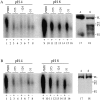Evidence for novel pH-dependent regulation of Candida albicans Rim101, a direct transcriptional repressor of the cell wall beta-glycosidase Phr2
- PMID: 16963637
- PMCID: PMC1563585
- DOI: 10.1128/EC.00088-06
Evidence for novel pH-dependent regulation of Candida albicans Rim101, a direct transcriptional repressor of the cell wall beta-glycosidase Phr2
Abstract
Candida albicans is a commensal fungus of mucosal surfaces that can cause disease in susceptible hosts. One aspect of the success of C. albicans as both a commensal and a pathogen is its ability to adapt to diverse environmental conditions, including dramatic variations in environmental pH. The response to a neutral-to-alkaline pH change is controlled by the Rim101 signal transduction pathway. In neutral-to-alkaline environments, the zinc finger transcription factor Rim101 is activated by the proteolytic removal of an inhibitory C-terminal domain. Upon activation, Rim101 acts to induce alkaline response gene expression and repress acidic response gene expression. Previously, recombinant Rim101 was shown to directly bind to the alkaline-pH-induced gene PHR1. Here, we demonstrate that endogenous Rim101 also directly binds to the alkaline-pH-repressed gene PHR2. Furthermore, we find that of the three putative binding sites, only the -124 site and, to a lesser extent, the -51 site play a role in vivo. In C. albicans, the predicted Rim101 binding site was thought to be CCAAGAA, divergent from the GCCAAG site defined in Aspergillus nidulans and Saccharomyces cerevisiae. Our results suggest that the Rim101 binding site in C. albicans is GCCAAGAA, but slight variations are tolerated in a context-dependent fashion. Finally, our data suggest that Rim101 activity is governed not only by proteolytic processing but also by an additional mechanism not previously described.
Figures







References
-
- Adams, A., D. E. Gotschling, C. A. Kaiser, and T. Stearns. 1997. Methods in yeast genetics. Cold Spring Harbor Laboratory Press, Cold Spring Harbor, N.Y.
-
- Bailey, C. R., H. A. Penfold, and H. N. Arst, Jr. 1979. cis-dominant regulatory mutations affecting the expression of GABA permease in Aspergillus nidulans. Mol. Gen. Genet. 169:79-83. - PubMed
-
- Bensen, E. S., S. J. Martin, M. Li, J. Berman, and D. A. Davis. 2004. Transcriptional profiling in C. albicans reveals new adaptive responses to extracellular pH and functions for Rim101p. Mol. Microbiol. 54:1335-1351. - PubMed
Publication types
MeSH terms
Substances
Grants and funding
LinkOut - more resources
Full Text Sources
Molecular Biology Databases

